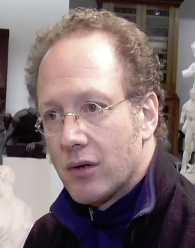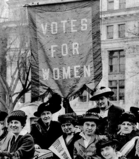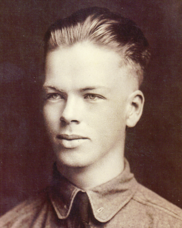|
|
|
|
|
|
"Doughboys Leave New Jersey for UK - in 2020!" Webinar Friday, September 11
In 1917 and 1918, America sent many Doughboys “Over There” from our shores in New Jersey, headed for the UK and the nation’s entry into World War I. In September 2020, the first 11 figures of the 48-figure bronze sculpture “A Soldier’s Journey” being created for the National World War I Memorial are getting ready to ship out for the foundry in the UK, where, like the raw Doughboys of 100 years ago were turned into an incredible fighting force, the clay sculpted figures will be cast into enduring metal.
Before this first contingent ships out, you have a last and unique opportunity to view the entire 48-figure ensemble, assembled in the Englewood, NJ studio where they are being created by sculptor Sabin Howard, during our "The Doughboys Leave New Jersey for the UK - in 2020!" webinar on Friday, September 11, 1:00 p.m. EDT.
This webinar is the last chance to see all 48 figures assembled at full scale in one place until the completed bronze sculpture is installed at the national WWI Memorial in Washington, DC several years from now.

We will open the webinar with an update on the Memorial construction, and reveal when the fences are coming down for public access to the National WWI Memorial. Next, historian and author Dr. Mitchell Yockelson (left) will give us some insight into what was happening in New Jersey 100 years ago as the newly minted soldiers and raw recruits prepared to embark for the war zone and combat.
|

Then Master Sculptor Sabin Howard (right) will walk us through the 48 clay figures, in different stages of completion, which are being created for eventual casting into bronze. You’ll get a close look at the intricate details of the sculpting from the artist himself, and a deep understanding of the creative process.
And apropos our theme, we are closing with the short documentary "How WWI Changed America: Going To War”.
Click here to register for this unique webinar. Advance registration is required, so sign up now!
|
Updates to WWI Memorial "Virtual Explorer” App published in August
 |
|
A new release was published in late August that was the result of extensive user testing done the previous month. Release 1.2 iOS &1.4 Android feature a new “Getting Started” explainer video at the top of the app. Post-update testing resulted in all testers successfully using the app within a couple of minutes of starting it - a dramatic improvement.
Many other usability features have been updated to make the WWI Memorial Virtual Explorer not just easier to get going on, but also easier to use and enjoy. Testing and refining continues. Click here or the image at left to download the latest version.
|
The Countdown to Bells of Peace is continuing on our social media platforms Facebook, Twitter and Instagram, headed for November 11, 2020, when everyone is invited to toll the “Bells of Peace” in honor of all those who served and sacrificed in World War I.
Everyone who wants to participate but does not have a bell to toll, the Doughboy Foundation has committed to updating the Bells of Peace App for 2020. For those who are not familiar with it, the App allows users to select from 7 different bell sounds that will toll at 11am local time on November 11th. Since that is Veterans Day, the 11th hour, of the 11th day of the 11th month is the time to remember our Doughboys. With the Bells of Peace App open on their phones, organizations, individuals and groups can toll the bells together, 21 times, 5 seconds apart.
Unlike years past, the 2020 update of the Bells of Peace App will focus on allowing users as groups or individuals to test their tolling in advance to be sure the moment comes off without a hitch. Additionally, we are creating a social media aggregation inside the app so that anyone participating can share theirs as a group (even if all participants are remote) by posting to the #BellsOfPeace hashtag.
You can download the limited 2019 version NOW to play with the bell sounds because the same app will update to the 2020 version in October. Got to your phone’s App store and search for Bells of Peace.

While American women had been fighting for the right to vote for decades prior to the ratification of the 19th Amendment on August 18, 1920, it was not until World War I that their cause for political independence regained momentum, argues legal scholar Pamela S. Karlan. Interviewed on the Futurity web site, Karlan discusses what the 19th Amendment accomplished and the challenges that persist today. Click here to read the entire interview.
|

A man is only missing if he is forgotten.
Our Doughboy MIA this month is Private Homer A. Armstrong, of Philomath, Oregon.
Homer Alexander Armstrong was born January 18th, 1892 in the town of Paddock, in Gage County Nebraska to Irene and John E. Armstrong. Homer was one of three sons; himself, and younger brothers Clarence and John Jr. There had also been two girls born – one before Homer (Minnie, in 1888) and one just before Clarence (Louisa, in 1893) but both died in infancy. John Senior himself died in 1899 shortly before John Junior was born, and in 1904 Clarence died at age 9. In about 1910 Homer went to live with his mother’s sister and her husband, Mr. and Mrs. Alex J. Brown. Then, when Irene died in 1915, John Jr. joined them and they all moved to Philomath, Oregon.
Shortly before the declaration of war, Homer made the decision to enlist in the Oregon National Guard and was assigned to Company K of the 3rd Oregon Infantry, based in Corvallis. When the 3rd Oregon Infantry Regiment was federalized, they became the Headquarters Company of the 162nd Infantry Regiment/41st Division. After receiving training, Homer left with the 41st for France on December 12th, 1917.
In France the 41st Division was redesignated the 1st Depot Division and immediately began feeding its infantry units piecemeal into combat units to fill battle casualties. Homer was sent to the 32nd Division as a replacement sometime after May 1918, being assigned to Company D of the 127th Infantry. In late July the 32nd moved into the Chateau Thierry sector to relieve the 3rd Division, which had seen heavy combat over the previous three months.
On the night of July 29th, the 127th Infantry moved into the front lines under a terrible artillery barrage. At 1430 hours on July 30th, 1918 the 127th went over the top and followed a rolling barrage into the Bois des Grimpettes. They pushed through the woods until they were stopped by machine gun fire from the right flank. On this flank, from positions in the Bois de Cierges, the Germans continued to oppose every effort to advance, but the 127th gained the edge of those woods and established themselves there. During the night the Germans launched a counter attack from the Bois de Meuniere and a bayonet melee raged for hours in the dark, tangled woods, until the attacking force was finally routed.
On the morning of July 31st, the regiment was again in action, pushing their attack through the Bois de Meuniere and into the village of Cierges and beyond. North of the village they were held up by a withering hail of machine gun fire from Bellevue Farm, which the Germans had organized into a very strong center of resistance and which the U.S. artillery had failed to smother.
It was there, north of Cierges during heavy fighting that afternoon that Homer Armstrong was killed by machine gun fire. His comrades buried him in a hasty battlefield grave that day, the position of which was reported to Graves Registration Service. Nevertheless, when GRS officials went looking for the grave after the war, it could not be located. Homer remains missing to this day, and is memorialized on the Walls of the Missing at the Aisne-Marne American Cemetery at Belleau, France.
Postscript:
At the beginning of 2020, Doughboy MIA was contacted by Mr. Eric Niemann, the Mayor of Philomath, Oregon. The city council wished to honor Homer among the veterans from their town, but they were finding little information and asked if we could help. Slowed by Covid but undeterred, the Doughboy MIA team went to work and chronicled Homer’s story in a full report and sent it to Mayor Niemann. The result was that a city resolution was passed proclaiming July 31st ‘Homer Armstrong Day’ in Philomath. Thus it was that, 102 years after his death, Homer was again remembered, and will be every year from now on; to be forgotten no more.
And a man is only missing if he is forgotten.
This is a beautiful example of your donations at work. Because of your donations the research materials needed to investigate and chronicle Homer’s story were available to us. Thank you! You made a difference with us. And if you haven’t donated and would like to in order to be part of our work, hop on over to our website at www.ww1cc.org/mia and make your tax-deducible donation today.
|
|
|
|
|

Submitted by: Laura Lacey Caldwell {Daughter}
Lewis Lawrence Lacey born around 1895. Lewis Lacey served in World War 1 with the United States Army. The enlistment was in 1917 and the service was completed in 1919.
Story of Service
Military Biography
Corporal Lewis Lacey served in France during the Great War as a proud member of the 42nd Division of the American Expeditionary Forces.
The eldest son of Dr. Lewis and Forney (Beaumont) Lacey, he was born in San Antonio, Texas, on March 27, 1895, and raised in Austin, Texas, where his father established his medical practice on Congress Avenue, a stone’s throw from the Texas state capitol building.
Lewis Lacey, like his three younger brothers, was educated in the Austin public schools and later attended the University of Texas in that city. During his youth, when the stifling heat of summer blanketed Austin, Lewis and his brothers would spend their school vacation camping, swimming, fishing and hunting at nearby Lake Austin. Those early camping experiences undoubtedly helped prepare him for the primitive living conditions in the hastily constructed military training camps both in the United States and in France, where sometimes his only shelter was the pup tent he carried in his backpack.
On May 25, 1917, just one week after Congress passed the Selective Service Act, but before the first draft, Lewis, aged twenty-two years, enlisted in the Texas National Guard in Austin. He listed his occupation as “actor”, a career he had begun in high school and continued on stage in local Austin theaters. On July 5, 1917, he was conscripted to Camp Mabry, near Austin. From there he was transferred from to Camp Bowie, outside Ft. Worth, Texas, and assigned to Truck Company #2, 117th Supply Train, 42nd Division. While there he began his “Dearest Mother” correspondence, which he continued faithfully throughout the war.
|

|
|
|
|